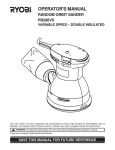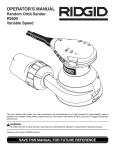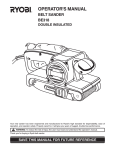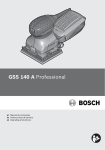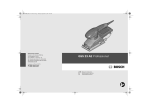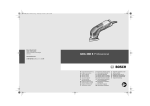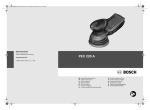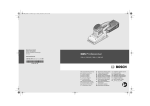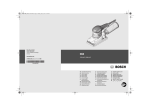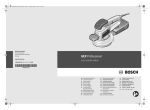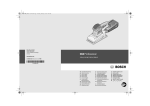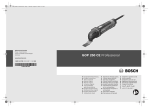Download Bosch GSS 23 AE Operating instructions
Transcript
OBJ_DOKU-7115-002.fm Page 1 Monday, September 10, 2007 4:41 PM Robert Bosch Limitada Divisão de Ferramentas Elétricas Via Anhangüera, km 98 CEP 13065-90 - Campinas - SP SAC Grande São Paulo (11) 2126-1950 SAC Demais localidades 0800 70 45446 www.bosch.com.br GSS 23 AE Professional F 000 622 247 (03/08) pt-BR Manual de instruções es Instrucciones de servicio en Operating instructions OBJ_BUCH-2 609 140 291-001.book Page 1 Thursday, July 7, 2005 8:36 AM 3 2 4 1 5 9 6 8 7 GSS 23 AE PROFESSIONAL OBJ_BUCH-2 609 140 291-001.book Page 1 Thursday, July 7, 2005 8:36 AM A B 7 5 8 9 6 7 D C 7 5 E F 10 6 11 OBJ_BUCH-2 609 140 291-001.book Page 1 Thursday, July 7, 2005 8:36 AM G1 G2 4 12 4 G3 G4 4 H 14 12 13 OBJ_BUCH-2 609 140 291-001.book Page 1 Thursday, July 7, 2005 8:36 AM General Safety Rules Read all instructions. Failure to follow all instructions listed below may result in electric shock, fire and/or serious injury. The term “power tool” in all of the warnings listed below refers to your mains operated (corded) power tool or battery operated (cordless) power tool. WARNING Save these instructions. 1) Work area a) Keep work area clean and well lit. Cluttered and dark areas invite accidents. b) Do not operate power tools in explosive atmospheres, such as in the presence of flammable liquids, gases or dust. Power tools create sparks which may ignite the dust or fumes. c) Keep children and bystanders away while operating a power tool. Distractions can cause you to lose control. 2) Electrical safety a) Power tool plugs must match the outlet. Never modify the plug in any way. Do not use any adapter plugs with earthed (grounded) power tools. Unmodified plugs and matching outlets will reduce risk of electric shock. b) Avoid body contact with earthed or grounded surfaces, such as pipes, radiators, ranges and refrigerators. There is an increased risk of electric shock if your body is earthed or grounded. b) Use safety equipment. Always wear eye protection. Safety equipment such as dust mask, non-skid safety shoes, hard hat, or hearing protection used for appropriate conditions will reduce personal injuries. c) Avoid accidental starting. Ensure the switch is in the off position before plugging in. Carrying power tools with your finger on the switch or plugging in power tools that have the switch on invites accidents. d) Remove any adjusting key or wrench before turning the power tool on. A wrench or a key left attached to a rotating part of the power tool may result in personal injury. e) Do not overreach. Keep proper footing and balance at all times. This enables better control of the power tool in unexpected situations. f) Dress properly. Do not wear loose clothing or jewellery. Keep your hair, clothing and gloves away from moving parts. Loose clothes, jewellery or long hair can be caught in moving parts. g) If devices are provided for the connection of dust extraction and collection facilities, ensure these are connected and properly used. Use of these devices can reduce dust related hazards. 4) Power tool use and care a) Do not force the power tool. Use the correct power tool for your application. The correct power tool will do the job better and safer at the rate for which it was designed. c) Do not expose power tools to rain or wet conditions. Water entering a power tool will increase the risk of electric shock. b) Do not use the power tool if the switch does not turn it on and off. Any power tool that cannot be controlled with the switch is dangerous and must be repaired. d) Do not abuse the cord. Never use the cord for carrying, pulling or unplugging the power tool. Keep cord away from heat, oil, sharp edges or moving parts. Damaged or entangled cords increase the risk of electric shock. c) Disconnect the plug from the power source before making any adjustments, changing accessories, or storing power tools. Such preventive safety measures reduce the risk of starting the power tool accidentally. e) When operating a power tool outdoors, use an extension cord suitable for outdoor use. Use of a cord suitable for outdoor use reduces the risk of electric shock. 3) Personal safety a) Stay alert, watch what you are doing and use common sense when operating a power tool. Do not use a power tool while you are tired or under the influence of drugs, alcohol or medication. A moment of inattention while operating power tools may result in serious personal injury. d) Store idle power tools out of the reach of children and do not allow persons unfamiliar with the power tool or these instructions to operate the power tool. Power tools are dangerous in the hands of untrained users. e) Maintain power tools. Check for misalignment or binding of moving parts, breakage of parts and any other condition that may affect the power tool’s operation. If damaged, have the power tool repaired before use. Many accidents are caused by poorly maintained power tools. English–1 OBJ_BUCH-2 609 140 291-001.book Page 2 Thursday, July 7, 2005 8:36 AM f) Keep cutting tools sharp and clean. Properly maintained cutting tools with sharp cutting edges are less likely to bind and are easier to control. g) Use the power tool, accessories and tool bits etc., in accordance with these instructions and in the manner intended for the particular type of power tool, taking into account the working conditions and the work to be performed. Use of the power tool for operations different from those intended could result in a hazardous situation. 5) Service a) Have your power tool serviced by a qualified repair person using only identical replacement parts. This will ensure that the safety of the power tool is maintained. B Caution, fire hazard! Avoid overheating the object being sanded as well as the sander. Always empty the dust collector before taking breaks. In unfavourable conditions, e. g., when sparks emit from sanding metals, sanding debris in the dust bag, micro filter or paper sack (or in the filter sack or filter of the vacuum cleaner) can selfignite. Particularly when mixed with remainders of varnish, polyurethane or other chemical materials and when the sanding debris is hot after long periods of working. Functional Description Read all instructions. Failure to follow all instructions listed below may result in electric shock, fire and/or serious injury. Machine-specific Safety Notes While reading the operating instructions, unfold the graphics page for the machine and leave it open. B Secure the workpiece. A workpiece clamped with clamping devices or in a vice is held more secure than by hand. Intended Use B Do not work materials containing asbestos. Asbestos is considered carcinogenic. B Take protective measures when dust can develop during working that is harmful to one's health, combustible or explosive. Example: Some dusts are regarded as carcinogenic. Wear a dust mask and work with dust/chip extraction when connectable. B Keep your workplace clean. Blends of materials are particularly dangerous. Dust from light alloys can burn or explode. B Never use the machine with a damaged cable. Do not touch the damaged cable and pull the mains plug when the cable is damaged while working. Damaged cables increase the risk of an electric shock. B Connect machines that are used in the open via a residual current device (RCD). B Use the machine only for dry sanding. Penetration of water into the machine increases the risk of an electric shock. The machine is intended for dry sanding of wood, plastic, filler and coated surfaces. Machine Elements The numbering of the machine elements refers to the illustration of the machine on the graphics page. 1 2 3 4 5 6 7 8 9 10 11 12 13 14 Thumbwheel for orbit frequency preselection On/Off switch Lock-on button for On/Off switch Dust box, complete (micro filtersystem) Sanding-sheet clamp Sanding plate Sanding sheet Release button for front clamping bracket Front clamping bracket Perforating tool* Screws for sanding plate Outlet piece Filter element (micro filtersystem) Vacuum hose* *Not all of the accessories illustrated or described are included as standard delivery. English–2 OBJ_BUCH-2 609 140 291-001.book Page 3 Thursday, July 7, 2005 8:36 AM Assembly Technical Data Orbital sander GSS 23 AE PROFESSIONAL 3 601 K70 7.. W 190 Article number Rated power input Preselection of orbital stroke rate No-load speed rpm Orbital stroke rate opm Orbit diameter mm Sanding sheet dimensions — Adhesion via Velcro backing mm — Attachment via clamping mm Sanding plate dimensions mm Weight according to EPTA-Procedure 01/2003 kg Protection class z 7000–12000 14000–24000 2.0 93 x 185 93 x 230 92 x 182 1.7 /II The values given are valid for nominal voltages [U] of 230/240 V. For lower voltage and models for specific countries, these values can vary. Please observe the article number on the type plate of your machine. The trade names of the individual machines may vary. *For the number 3 601 K70 7E0 no-load speed 8.000 - 10.500 Dust/Chip Extraction Integrated Dust Extraction with Dust Box (see figures G1–G4) Attach the dust box 4 onto the outlet piece 12 until it latches. To empty the dust box 4, pull off the dust box downward. Before opening the dust box 4, it is recommended to loosen the dust from the filter element by gently striking it against a firm support (as shown in the figure). Grasp the dust box 4 by the recessed grip, fold the filter element 13 upward and empty the dust box. Clean the thin plates of the filter element 13 with a soft brush. External Dust Extraction (see figure H) Insert a vacuum hose 14 onto the outlet piece 12. Connect the vacuum hose 14 to a vacuum cleaner. See the overview for connecting to various vacuum cleaners at the end of these operating instructions. The vacuum cleaner must be suitable for the material being worked. When vacuuming dry dust that is especially detrimental to health or carcinogenic, use a special vacuum cleaner. min-1 and orbital stroke rate 16.000 - 21.000 min-1. Noise/Vibration Information Replacing the Sanding Sheet Measured values determined according to EN 60745. Before any work on the machine itself, pull the mains plug. Typically the A-weighted sound pressure value of the machine is 80 dB(A). Measuring uncertainty K=3 dB. The noise level when working can exceed 85 dB(A). Wear hearing protection! The typically weighted acceleration is 4.0 m/s2. Declaration of Conformity We declare under our sole responsibility that this product is in conformity with the following standards or standardization documents: EN 60745 according to the provisions of the directives 89/336/EEC, 98/37/EC. Dr. Egbert Schneider Senior Vice President Engineering Dr. Eckerhard Strötgen Head of Product Certification Robert Bosch GmbH, Power Tools Division When attaching a new sanding sheet, remove any dust or debris from the sanding plate 6 (e. g. with a brush). To ensure optimum dust extraction, pay attention that the punched holes in the sanding sheet match with the holes in the sanding plate. Sanding Sheets with Velcro Backing (see figure A) The sanding plate 6 is fitted with Velcro backing for quick and easy fastening of sanding sheets with Velcro adhesion. Before attaching the sanding sheet 7, free the Velcro backing of the sanding plate 6 from any debris by tapping against it in order to enable optimum adhesion. Position the sanding sheet 7 flush alongside one edge of the sanding plate 6, then lay the sanding sheet onto the sanding plate and press it against it with a light turning motion in clockwise direction. To remove the sanding sheet 7, grasp it at one of the tips and pull it off from the sanding plate 6. English–3 OBJ_BUCH-2 609 140 291-001.book Page 4 Thursday, July 7, 2005 8:36 AM Sanding Sheets without Velcro Backing (see figures B–D) n Press the release button 8 and keep it depressed. Replacing the Sanding Plate (see figure F) o Guide the sanding sheet 7 to the stop under the opened front clamping bracket 9 and let go of the release button 8 again. Pay attention that the sanding sheet is clamped centrally. Before any work on the machine itself, pull the mains plug. p Press the sanding sheet clamp 5 inward and pivot it to the stop. Unscrew the 4 screws 11 completely and remove the sanding plate 6. Attach the new sanding plate 6 and tighten the screws again. q Fold the sanding sheet 7 firmly around the sanding plate. Guide the other end of the sanding sheet 7 between the rear clamping bracket and the red roller on the clamping bracket 5. r Hold the sanding sheet tensely and press the clamping bracket 5 toward the sanding plate to lock the sanding sheet. The sanding plate 6 can be replaced, if required. Operation Starting Operation Sanding sheets without holes, e. g. from rolls or by the meter, can be punctured with the perforating tool 10 for use with dust extraction. For this, press the machine with the mounted sanding sheet onto the perforating tool (see figure E). Observe correct mains voltage! The voltage of the power source must agree with the voltage specified on the nameplate of the machine. Power tools marked with 230 V can also be operated with 220 V. To remove the sanding sheet 7, loosen the clamping bracket 5 and pull out the sanding sheet from the rear holding fixture. Press the release button 8 and completely remove the sanding sheet. Switching On and Off To start the machine, press the On/Off switch 2 and keep it depressed. Selecting the Sanding Sheet Depending on the material to be worked and the required rate of material removal, different sanding sheets are available: Grain size Preselecting the Orbital Stroke Rate With the thumbwheel for preselection of the orbital stroke rate 1, you can preselect the required orbital stroke rate, even during operation. 40, 60 The required stroke rate depends on the material and the working conditions and can be determined through practical testing. For face sanding and planing medium 80, 100, 120 small irregularities For finish and fine sanding of fine hard woods To switch off the machine, release the On/Off switch 2 or when it is locked with the lock-on button 3, briefly press the On/Off switch 2 and then release it. 40—240 For the working of all wooden materials For coarse-sanding, e. g. of coarse rough, unplaned beams and boards To lock the pressed On/Off switch 2, press the lockon button 3. Operating Instructions 180, 240 B Wait until the machine has come to a standstill before placing it down. 40—320 The removal capacity during sanding is mainly determined by the selection of the sanding sheet as well as the preselected orbital stroke rate. For the working of paint/enamel coats or primers and fillers Only flawless sanding sheets achieve good sanding capacity and extend the service life of the machine. Pay attention to apply uniform sanding pressure; this increases the working life of the sanding sheets. For sanding off paint coarse 40, 60 For sanding primer medium 80, 100, 120 For final sanding of primers before coating fine 180, 240, 320 Intensifiying the sanding pressure does not lead to an increase of the sanding capacity, but to increased wear of the machine and the sanding sheet. A sanding sheet that has been used for metal should not be used for other materials. Use only original Bosch sanding accessories. English–4 OBJ_BUCH-2 609 140 291-001.book Page 5 Thursday, July 7, 2005 8:36 AM Maintenance and Service Maintenance and Cleaning Disposal Before any work on the machine itself, pull the mains plug. The machine, accessories and packaging should be sorted for environmental-friendly recycling. For safe and proper working, always keep the machine and ventilation slots clean. Only for EC countries: If the machine should fail despite the care taken in manufacturing and testing procedures, repair should be carried out by an after-sales service centre for Bosch power tools. In all correspondence and spare parts order, please always include the 10-digit article number given on the type plate of the machine. WARNING! Important instructions for connecting a new 3-pin plug to the 2-wire cable. The wires in the cable are coloured according to the following code: Do not dispose of power tools into household waste! According the European Guideline 2002/96/EC for Waste Electrical and Electronic Equipment and its implementation into national right, power tools that are no longer usable must be collected separately and disposed of in an environmentally correct manner. Subject to change without notice. Do not connect the blue or brown wire to the earth terminal of the plug. Important: If for any reason the moulded plug is removed from the cable of this power tool, it must be disposed of safely. Guarantee We guarantee Bosch appliances in accordance with statutory/country-specific regulations (proof of purchase by invoice or delivery note). Damage attributable to normal wear and tear, overload or improper handling will be excluded from the guarantee. In case of complaint please send the machine, undismantled, to your dealer or the Bosch Service Center for Electric Power Tools. Warning! Freight and insurance costs are charged to the client, even for warranty claims. F 000 622 247 • 13.11.07 English–5









